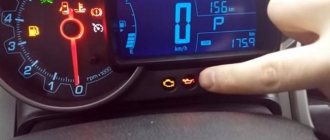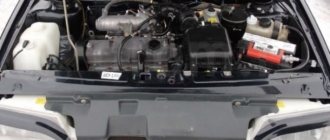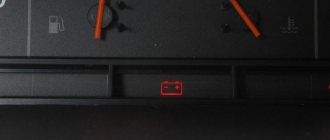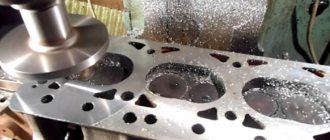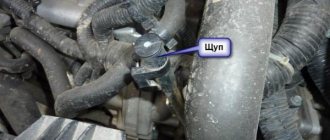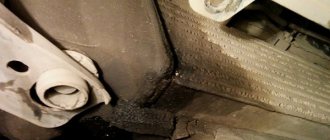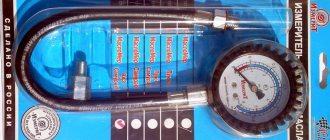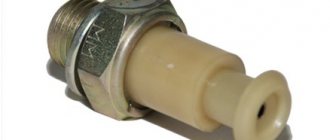28.10.2019
| (Votes: 1, Rating: 5) |
Issues discussed in the material:
- What functions does the oil pressure sensor perform in a car?
- When does the oil light come on on a car?
- What to check if the oil pressure light comes on at idle
- How to check the oil pressure in a car
Among all types of automobile malfunctions, there are several truly unpleasant situations for the car owner, and one of these is a low pressure alarm in the oil system. What to do in this case? Should I move on or call a tow truck? In fact, the reasons why the oil light comes on at idle can be different and not always serious.
Why do you need an oil pressure indicator in a car?
Any car is equipped with indicators on the front panel that indicate the malfunction of a particular component. The oil light is red. When the engine is running at idle speed, this means that there is a problem that needs to be fixed.
Ignoring this indication may lead to dangerous consequences. Therefore, every driver should clearly know what to do when the light starts to light up.
Older passenger car models had a dashboard with a separate block with a scale that showed the current pressure in the engine, measured in kilogram-force per square centimeter (kgf/sq. cm). Accordingly, the higher this value, the higher the crankshaft speed. If the pressure dropped below the minimum permissible value at idle, the light began to light. The driver was thus notified of the presence of a malfunction.
How is the alarm system implemented in modern cars, where this scale has long been absent? Probably, some domestic models still contain a panel with this indicator. But there are very few such examples today, and all drivers need to know the standard pressure parameters.
At idle (at 800-1000 rpm), the pressure in the system, as a rule, does not fall below 0.5 kgf/sq.m. cm. Most 16-valve engines have a slightly higher threshold - 0.6 kgf/sq.m. cm. These units are characterized by high operating speeds and consume thinner oil.
To diagnose the oil system in modern cars, a mechanical oil pressure sensor is used, which, if it deviates from the norm, gives a signal and the light starts to light at idle. By the glowing indicator, the driver determines that there is a malfunction in the motor. The light flashes or stays on continuously for some time when the pressure drops below 0.4 kgf/sq. cm.
If the emergency lubricant pressure indicator lights up, you need to take immediate action to eliminate the problem. First of all, you need to turn off the engine. Even if it works normally, and the light continues to light at idle, the consequences can be dire, including engine failure. This, in turn, will mean unnecessary and unreasonable repair costs.
Since the engine is the most expensive part of the car (not counting the catalyst, which may be missing), it is better to take timely measures to prevent the unit from failing.
We recommend
“The oil pressure light is on in a Volkswagen: all possible reasons” Read more
The lubrication system in a modern engine plays an important role. The most important functions of the system are:
- lubrication of rubbing surfaces of moving elements (pistons, crankshaft, rings, valves, liners);
- partial heat removal from the combustion chamber;
- flushing the resulting metal shavings into the tray;
- creating a protective film on the surfaces of parts to counteract corrosion.
If the oil pressure light is on at idle, any of these functions may be impaired. Therefore, it is necessary to respond to this situation in a timely manner. The functionality of the systems will be fully ensured only when the engine is configured to optimal operating parameters. If everything is normal, the indicator will not show itself in any way.
There needs to be a good reason for the light to come on at idle. For example, a pressure drop below the minimum permissible forces the engine to work with increased load, and this is already an emergency situation. In this case, the heat dissipation function is disrupted, as a result of which the cylinder block may overheat. There is a considerable probability of complete failure of the piston group.
What oil pressure should be at idle?
The optimal oil pressure at idle speed differs for different brands of engines. The design of the power unit affects this.
At idle, the pressure of domestic passenger cars does not drop below 0.2 bar, while for diesel engines the figure is approximately 0.3 bar. For ZMZ engines the pressure is about 0.4 bar, for foreign cars with a power unit volume of 1.4 liters, the pressure is approximately 0.6 bar.
Exact data is indicated in the user manual.
What to check if the oil light comes on at idle
If you find that the indicator lights up at idle, first of all you need to find the source of the breakdown, which you can then fix as soon as possible yourself or at the nearest service station.
- Reduced oil level
Most often, the reason that the light is on is that the oil pressure in the pan is too low or the lubricant completely leaks out at idle. Unfortunately, many car owners habitually ignore the requirements of the instructions.It states: before leaving the parking lot or garage on the road, you must check the levels of all engine fluids, including oil. The deficiency must be made up. The engine and engine compartment should be inspected regularly for leaks. When the light is on at idle, such leaks are easy to detect.
To determine the current oil level, you need to turn off the engine, open the hood and use a special dipstick equipped with marks by which the level is determined. The lack of oil will be immediately visible, and all that remains is to add fluid.
- Sensor check
The emergency light located on the dashboard operates from the sensor and is powered by a wire common to it. Therefore, when the lubricant level drops below a critical level, the indicator shorts to ground, as a result of which it begins to burn. Accordingly, under normal conditions the sensor is in an open state and the oil light does not light up.The circuit in a faulty sensor is always closed at idle speed, for this reason the indicator also lights up constantly, regardless of the current pressure in the system. If the sensor fails, it must be replaced - it cannot be repaired.
You can check the serviceability of the sensor as follows. The engine is started and warmed up, after which the lever is moved to the neutral position and the gas pedal is pressed to idle all the way, holding it until 1000-1100 crankshaft revolutions per minute are reached. If the light stops turning on, the sensor is likely faulty. To verify this, this element can be removed and a pressure gauge for measuring pressure installed in its place. A value that corresponds to the standard will mean the sensor is inoperable and needs to be replaced. If the pressure gauge reading is below the minimum acceptable level, the sensor is fine and gives the correct alerts at idle speed.
We recommend
“Is it possible to add oil of a different brand and composition to the engine?” Read more
- Checking oil pressure and viscosity
High-quality engine oil has good viscosity. To check, carefully inspect the dipstick and the contents of the pan. If the lubricant is too thin, it is time to change it or it has long expired. Using liquid waste oil at idle speed and beyond leads to rapid engine wear. It is advisable to replace it at every scheduled inspection. - Problems with the oil filter.
Companies that carry out their work responsibly value their reputation. Therefore, they strive to produce the highest quality and reliable products. However, there are also “handicraftsmen” who definitely do not care about the quality of the filters produced. As a result, the market was flooded with products at very low prices. - Such filters will not be able to withstand the operating oil pressure in the engine, while modern high-quality products cope with this task quite well. This nuance should be taken into account when the oil pressure light comes on at idle. Perhaps the reason lies in a low-quality part.
After turning off the engine, the original oil filter retains a certain amount of lubricant, which makes it possible to avoid oil starvation at the next start. Cheap products do not have this function, and at idle speed the oil completely flows into the sump. In this case, there is a risk of increased wear of rubbing parts, which threatens early engine failure.
If, as a result of changing the engine oil, the indicator blinks at idle for more than 10-15 seconds, this may indicate a filter malfunction. You can verify this visually.
- Oil pump malfunction
To check the condition of the pump, you will need to remove the oil pan. It is quite difficult to perform this operation without outside help, at least in foreign cars. Therefore, at idle speed, at the first suspicion of a faulty unit (the pressure light is on), it is advisable to carry out professional diagnostics at a service station. - Oil pump strainer is clogged
The mesh serves to protect the motor and pump from various contaminants (chips, dust, abrasive particles), so it is required for normal operation of the car.Clean oil entering the pump passes freely through the filter. Contaminated lubricant with impurities clogs the mesh and penetrates through it with difficulty, as a result of which normal pressure is not maintained in the system. The oil light reacts to this and starts to light up at idle speed. To eliminate this problem, simply remove the filter, clean it thoroughly and install it back.
We recommend
“How to check the oil in the gearbox and replace it if necessary” Read more
- Problems with pressure reducing valve
A serviceable valve is always closed, but during operation it may become stuck or jammed. In this case, it opens and becomes unable to maintain normal pressure in the oil system at idle speed, as indicated by the oil light on the dashboard starting to light up.There are two ways to resolve this problem:
- If the spring is stretched, it needs to be replaced.
If the valve is heavily soiled, it will need to be removed, cleaned and reinstalled if there is no damage.
- Engine wear
In engines with high mileage, oil may leak, which will cause the pressure in the system to drop at idle. Wear and prolonged use of the engine lead to greater consumption of lubricant. At the same time, strange noises arise in the engine, and the oil pressure light begins to light periodically. To eliminate the malfunction, you need to replace worn parts or perform a major overhaul of the power unit.
It is necessary to regularly carry out preventive maintenance, which consists of checking the lubrication level and replacing the oil filter. You need to make sure that there are no impurities in the oil. Before changing the lubricant, the system must be flushed.
The main reasons for the oil pressure warning light to come on
So, the warning light usually lights up after starting the engine or when it is idling. There may be several reasons for this phenomenon, but the main thing is to understand and accept for yourself that this should be a signal that there is some kind of malfunction. Therefore, you need to take appropriate measures so as not to worsen the situation. In any case, if the lamp blinks, it means that you need to identify the malfunction and do everything to eliminate it as soon as possible.
Among the main reasons for the indicator to light up are the following:
- Reduced lubricant pressure in the system. This is one of the most common reasons, but even today there are owners who stubbornly do not notice signs of oil leakage or do not look into the engine compartment. Why does pressure drop, you ask? Because the oil gradually leaves the system. Therefore, you should pay attention to any stains on the engine or under the car where it is parked. Do not forget that by simply adding lubricant to the system, you do not solve the problem, but only forget about it for a while.
- Another reason for the warning light to blink is due to the use of low-quality oil filters. Some of the lubricant remains in them even when you stop the engine. If the filter is of dubious quality, then it does not retain oil, but it directly flows into the crankcase. Thus, a periodic drop in pressure occurs.
Lack of lubrication may be associated with failure of the pressure relief valve. It should be in the closed position if the pressure level in the system is insufficient. However, when the valve fails or gets stuck, the pressure generated is not enough, which causes the warning light to light up.- Another reason is a faulty pressure sensor. It is directly related to the operation of the control indicator, since it is connected to it by the same wire. As soon as the pressure returns to normal, the contacts should open, as a result of which the indicator should go out. This will not happen if the sensor itself has become faulty.
- The indicator also starts blinking if the oil pump screen is clogged. It acts as an obstacle to particles of dirt, metal, dust and any other unwanted elements that lead to wear on the pump. If the oil is not dirty, but of normal quality, then it freely penetrates through the mesh. When it is contaminated, the required pressure is not created in the system, which leads to the warning lamp coming on. Most often, this reason manifests itself on a cold engine, because as it warms up, the lubricant becomes more liquid and passes through the mesh much more easily.
The oil pump itself may also fail. It is this that creates an acceptable level of pressure in the entire system. If this does not happen, the sensor contacts close, which leads to the appearance of a signal indicator on the panel. Therefore, in this case, you will have to dismantle the oil pan and pump to eliminate the problem.
How to check the oil pressure in a car
Normal operation of the engine, both at low and high speeds, is ensured by a certain pressure of the lubricating fluid. The required level is indicated in the vehicle operating instructions. For example, the operating parameters for Priora look like this:
- 2 bar (196 kPa) at idle speed on a warm engine;
- 4.5-6.5 bar at 5400 rpm.
On average, for passenger models this value is 2 bar and 4-6 bar, respectively, at idle and at high speeds.
As already mentioned, modern cars are equipped only with a warning light that lights up at idle when the pressure drops. A full-fledged pressure gauge, as a rule, is not available. Because of this, it is often difficult to determine the cause of the indicator signal - either there is a normal lack of oil, or there is a serious problem.
In any case, there is a risk of engine damage when this light is on at idle. How to check the pressure in the absence of a built-in device? A special oil pressure gauge is used for this purpose.
The procedure for working with it is as follows:
- The engine is started, which then warms up to an operating temperature of 90 degrees Celsius.
- After this, the engine is turned off and the hood is opened.
- Find the emergency lubricant pressure sensor and disconnect it. A pressure gauge is connected in its place. Care must be taken as the engine oil is very hot.
- The device is used to determine the current liquid level. If necessary, add oil.
- Then the engine is started again.
- Measure the pressure first at idle, then at high crankshaft speeds.
Repeat the diagnosis 2-3 times and calculate the average value for greater accuracy of the result. Be aware that some fluid may spill out when disconnecting the pressure gauge. Therefore, it is advisable to re-measure the oil level using a dipstick after installing the sensor. If the level is insufficient, add lubricant.
Oil light is on: opinions of car enthusiasts
- “We need to check it consistently”
“First determine the current oil pressure in the system at idle speed and only then decide whether it is working properly or not. If the pressure is normal, the sensor is faulty. If it is low, it may be a problem with the earbuds.Pressure problems can be solved by using additives. A friend of mine, having found himself in such a situation, filled it with phenom. The light stopped burning. He drove his car for another year and then sold it without any problems.”
- “Normal oil solved the problem”
“I’ll tell you how it happened for me. There's nothing wrong with the sensor. After changing the oil, the indicator stopped flashing. And it all started when, after Liqui Moly, I poured Toyota grease into my Corolla. I did this twice and topped it up the same number of times after 7000-8000 km. As a result, I noticed that the oil pressure light was constantly on at idle. And it doesn’t just light up, it blinks. I finally decided to fill it with Liqui Moly with SMT 2, and the blinking disappeared. Yes, this is a more expensive option, but as they say, the miser pays twice.” - “I’m not particularly worried.”
“Now I don’t even look at the light bulb. It first started burning at the beginning of 2011, and with the arrival of summer it went out. Not long ago the light came on again. Apparently, the temperature outside has a big effect on it.” - “Allowed only in the first seconds of engine operation”
“A glowing indicator at idle indicates low pressure in the oil system. As the speed increases, the performance of the oil pump increases, and the pressure drops. Maybe the wrong oil was poured in, or it might be a faulty pump.Normally, the light comes on for only a few fractions of a second when the engine starts. A working anti-drainage valve in the oil filter will not allow oil to drain, which should immediately begin to circulate through the system as soon as the engine starts. Accordingly, a certain pressure is established in the oil system immediately at idle. In my car, the light goes out and the pressure reaches the required value immediately after the starter starts rotating.”
Why does the oil pressure light come on?
The vehicle's warning lamps are controlled by the on-board monitoring system (OBS). It is designed to notify the driver of malfunctions or malfunctions of vehicle systems using these same light bulbs. In addition, the BSK is responsible for indicating turn signals, turning on high beams, rear fog lights, signaling the parking brake is applied, and so on.
The oil pressure and level light is also controlled by the on-board control system. On modern cars these are two different indicators, but on older cars there is one that lights up when the engine oil pressure in the crankcase is low.
This light bulb looks like an oil can. It lights up yellow when the oil level is below normal, and red when the pressure in the system has dropped. On some modern cars, instead of an indicator, the corresponding inscriptions are displayed on the on-board computer.
Both lights can light up independently of each other because they receive data from two different sensors.
Let's look at the reasons why the oil level/pressure lights may come on.
The oil level in the crankcase is below the specified level
This problem is both the simplest and the most terrible. During operation, any engine consumes one or another amount of engine oil. Therefore, if the amount of missing fluid falls within normal conditions, then it will be enough to simply replenish the oil level.
The worst thing is when the reason for the drop in oil level is insufficient sealing of the engine or the oil leak is caused by a serious malfunction.
When the oil level is below the required level, the pressure sensor sends a signal to the electronic control unit, which notifies the BSK about the problem. Accordingly, the light on the dashboard is activated. In this case, the lamp itself does not blink, but is constantly on. This can happen both at idle and while driving, on a hot or cold engine, etc.
The oil pressure light also comes on when the ignition is turned on, but after starting the engine, if there are no problems, it goes out. In addition, it can turn on during ascent or descent, when engine oil collects in one part of the crankcase, leaving the other dry. If there are no faults, it will go out when the car is leveled.
If, after starting the engine or leveling the car after lifting/lowering, it continues to burn, you need to go to a car service center and find out the reason.
Using oil of the wrong viscosity
This problem is especially relevant in the winter season. If engine oil thickens at subzero temperatures, it is harder for the pump to pump it. Accordingly, the pressure turns out to be insufficient, which is recorded by the corresponding sensor.
Oil filter problems
There is always some amount of engine oil in the oil filter. This is necessary so that there is no oil starvation when starting the engine. Therefore, the design of the filters may include a check valve or a locking washer that retains the lubricant when the internal combustion engine is turned off.
But on low-quality filters, such components are either completely absent or do not cope with their task. Thus, the oil flows back into the oil pan. Accordingly, after startup, when the power unit gains pressure, it experiences oil starvation, which leads to increased wear. In this case, the indicator lights up for a few minutes and then disappears.
But a clogged oil filter causes much more problems. It not only creates additional stress on the oil pump, but also helps reduce pressure in the system.
Sensor malfunction
If the oil level sensor is faulty, the light will remain on constantly. Most often this happens because its slider is stuck or another breakdown has occurred, which depends on the design of the sensor. The same is true for the oil pressure sensor.
Oil pump malfunctions
Depending on what type of oil pump your vehicle has, the reasons why it fails will vary. In this case, the oil pressure light will be constantly on or flashing.
But if the oil filter mesh is clogged, then the signs are exactly the same as with a clogged filter. In addition to the fact that contamination leads to a decrease in oil level and pressure, it forces the oil pump to work harder to pump oil through the system.
Engine malfunctions
Let's talk about the most dangerous reasons. All of them are related to the condition of the engine and its specific components.
The most common reason why pressure and oil level lights come on is a leak. Most often, lubricant escapes through leaking gaskets and O-rings, pipes, oil lines, etc.
Clogged oil passages are also the cause of light bulbs. This is especially true for foreign cars where the engine oil channels are quite narrow, for example, in VAG cars. Accordingly, in such machines it is necessary to use only motor oils and high-quality fuel recommended by the manufacturer.
Wear of the cylinder-piston group of the internal combustion engine also leads to a drop in oil level and pressure. In this case, adding lubricant will help only for a short period of time, because oil consumption for waste will increase significantly. This problem can only be solved through a major overhaul of the power unit.
Antifreeze or gasoline getting into the engine oil
This usually indicates a failed cylinder head gasket. Externally, this is expressed by a constant drop in the coolant level without visible leaks, the appearance of white smoke from the exhaust pipe, the presence of a smell of fuel or coolant from engine oil, the formation of an emulsion, etc.
There are situations when the engine oil level is normal, but the oil pressure lamp is still on. In this case, the cause may be a poor-quality or clogged oil filter, a faulty oil pump, or antifreeze or gasoline getting into the lubricant.
